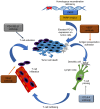Combinatorial therapy of immune checkpoint and cancer pathways provides a novel perspective on ovarian cancer treatment
- PMID: 30854033
- PMCID: PMC6365948
- DOI: 10.3892/ol.2019.9902
Combinatorial therapy of immune checkpoint and cancer pathways provides a novel perspective on ovarian cancer treatment
Abstract
An increasing number of studies have reported that immunotherapy serves a significant role in ovarian cancer treatment. In recent years, blockade of checkpoint pathways, including programmed death-ligand 1 (PD-L1)/programmed death-1 and cytotoxic T-lymphocyte-associated protein 4, has demonstrated significant clinical and preclinical benefits in the treatment of ovarian cancer. Additionally, tumor-associated angiogenesis and homologous recombination deficiency frequently occurs in patients with high-grade ovarian cancer, which makes cancer cells more susceptible to targeted therapies, including therapies targeting poly (ADP-ribose) polymerase inhibitor, and anti-angiogenic approaches. Additionally, targeted therapy has been associated with elevated PD-L1 expression in tumor cells, increased T-cell infiltration in tumors and dendritic cell stimulation. This synergistic effect provides the rationale for the joint application of targeted therapy and immunotherapy. Checkpoint blockades are able to elicit durable antitumor immune reactions and complement the transient antitumor effect of targeted therapies. The current review discusses the underlying mechanism of these therapies and novel developments in combined therapy for the treatment of ovarian cancer.
Keywords: anti-angiogenesis; cytotoxic T-lymphocyte-associated protein 4; ovarian cancer; poly (ADP-ribose) polymerase inhibitor; programmed death 1; programmed death-ligand 1; vascular endothelial growth factor.
Figures

Similar articles
-
Niraparib exhibits a synergistic anti-tumor effect with PD-L1 blockade by inducing an immune response in ovarian cancer.J Transl Med. 2021 Oct 7;19(1):415. doi: 10.1186/s12967-021-03073-0. J Transl Med. 2021. PMID: 34620163 Free PMC article.
-
PD-1/PD-L1 Blockade Therapy in Advanced Non-Small-Cell Lung Cancer: Current Status and Future Directions.Oncologist. 2019 Feb;24(Suppl 1):S31-S41. doi: 10.1634/theoncologist.2019-IO-S1-s05. Oncologist. 2019. PMID: 30819829 Free PMC article. Review.
-
The Next Immune-Checkpoint Inhibitors: PD-1/PD-L1 Blockade in Melanoma.Clin Ther. 2015 Apr 1;37(4):764-82. doi: 10.1016/j.clinthera.2015.02.018. Epub 2015 Mar 29. Clin Ther. 2015. PMID: 25823918 Free PMC article. Review.
-
Programmed death-1 pathway blockade produces a synergistic antitumor effect: combined application in ovarian cancer.J Gynecol Oncol. 2017 Sep;28(5):e64. doi: 10.3802/jgo.2017.28.e64. Epub 2017 Jun 5. J Gynecol Oncol. 2017. PMID: 28657225 Free PMC article. Review.
-
Immune checkpoint therapy in liver cancer.J Exp Clin Cancer Res. 2018 May 29;37(1):110. doi: 10.1186/s13046-018-0777-4. J Exp Clin Cancer Res. 2018. PMID: 29843754 Free PMC article. Review.
Cited by
-
Activity of PD-1 Inhibitor Combined With Anti-Angiogenic Therapy in Advanced Sarcoma: A Single-Center Retrospective Analysis.Front Mol Biosci. 2021 Nov 16;8:747650. doi: 10.3389/fmolb.2021.747650. eCollection 2021. Front Mol Biosci. 2021. PMID: 34869583 Free PMC article.
-
The biomarker HE4 (WFDC2) promotes a pro-angiogenic and immunosuppressive tumor microenvironment via regulation of STAT3 target genes.Sci Rep. 2020 May 22;10(1):8558. doi: 10.1038/s41598-020-65353-x. Sci Rep. 2020. PMID: 32444701 Free PMC article.
-
Ovarian cancer risk score predicts chemo-response and outcome in epithelial ovarian carcinoma patients.J Gynecol Oncol. 2021 Mar;32(2):e18. doi: 10.3802/jgo.2021.32.e18. Epub 2020 Dec 3. J Gynecol Oncol. 2021. PMID: 33327048 Free PMC article.
-
Deciphering the Molecular Mechanisms behind Drug Resistance in Ovarian Cancer to Unlock Efficient Treatment Options.Cells. 2024 May 4;13(9):786. doi: 10.3390/cells13090786. Cells. 2024. PMID: 38727322 Free PMC article. Review.
-
Clinical and Prognostic Value of Antigen-Presenting Cells with PD-L1/PD-L2 Expression in Ovarian Cancer Patients.Int J Mol Sci. 2021 Oct 26;22(21):11563. doi: 10.3390/ijms222111563. Int J Mol Sci. 2021. PMID: 34768993 Free PMC article.
References
Publication types
LinkOut - more resources
Full Text Sources
Other Literature Sources
Research Materials
